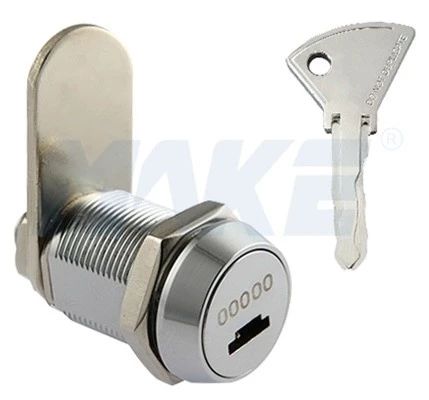A cam lock is a common type of lock in our daily life and industrial scenes. The cam lock is a widely used mechanical lock. Its principle is based on the rotation of the lock core and the up and down movement of the cam. Through the insertion and rotation of the key, the lock cylinder can control the movement of the cam, thereby unlocking and locking the lock. The cam lock is widely used in various fields due to their simplicity, reliability, and security. The applications of cam locks range from furniture manufacturing to commercial security systems. One common use of cam locks is in cabinets and drawers. They provide an effective way to secure personal belongings or important documents. Cam locks are also extensively used in the automotive industry, securing glove compartments or center consoles. Another significant application is in the field of healthcare. Cam locks are utilized in medicine cabinets, ensuring that medications and medical supplies are safely stored away from unauthorized access. Moreover, they can be found on hospital carts, securing valuable equipment such as defibrillators or portable ultrasound machines. In addition to these uses, cam locks play a crucial role in the gaming industry by securing cash boxes on slot machines or arcade games. They provide a reliable solution for preventing theft and tampering. Furthermore, cam locks find applications in mailboxes, lockers at gyms or schools, vending machines, file cabinets, and even electrical enclosures. Their versatility makes them an ideal choice for numerous industries where security is paramount.
What kind of structure do cam locks have?
Pins: they refer to the internal structure of the lock that controls the rotation of the lock. The lock pin is a copper pin. The advantage is that unlocking is smoother. Generally speaking, pin tumbler locks have 7 pins, which can reach nearly 10,000 kinds of keys and have good security. Tubular locks, double-sided pin tumbler locks and mortise pin tumbler locks all have pins.
Blades: refer to the internal structure of the lock that controls the rotation of the lock. The lock pin is a metal blade, which is commonly made of copper sheets and stainless iron sheets. The blade cam lock has the advantages of simple structure, easy processing and relatively low price, which are commonly used in mailbox locks, filing cabinets and toolboxes. Blade cam locks include ordinary plate locks and engraving locks. M3 and M4 high-security cam locks made by Make also belong to the blade cam lock.

When we use cam locks, there are some related terminologies. Common technical parameters of cam locks include the following aspects:
Mutual opening: the phenomenon that one lock can be opened with another key. Generally, the lower the mutual opening rate is, the higher the safety factor of the lock becomes.
Key shapes: A set of teeth of different heights arranged on the key.
Numbers of key patterns: The total number of different key tooth patterns in the batch.
Confidentiality: the degree of reliability of the lock's confidentiality. It is mainly determined by the structure, such as the arrangement of the blades and the action of the spring.
Firmness: The degree to which a lock is resistant to damage by external forces. The main consideration is the material used in the lock.
Length: the length of the blade determines whether the cam lock matches the device.
Durability: refers to the service life of the lock. There are two main considerations: one is the stability of the structure, and the other is the material used, such as anti-corrosion and being waterproof.
Universal systems: The universal system has the function of one key for multiple openings, that is, the same key can open or lock multiple cam locks. This function can help us solve the management of a large number of keys.
Make provides complete cam lock solutions with a wide range of applications, which can meet the security needs of most applications and protect the safety of application scenarios.
What kind of structure do cam locks have?
Pins: they refer to the internal structure of the lock that controls the rotation of the lock. The lock pin is a copper pin. The advantage is that unlocking is smoother. Generally speaking, pin tumbler locks have 7 pins, which can reach nearly 10,000 kinds of keys and have good security. Tubular locks, double-sided pin tumbler locks and mortise pin tumbler locks all have pins.
Blades: refer to the internal structure of the lock that controls the rotation of the lock. The lock pin is a metal blade, which is commonly made of copper sheets and stainless iron sheets. The blade cam lock has the advantages of simple structure, easy processing and relatively low price, which are commonly used in mailbox locks, filing cabinets and toolboxes. Blade cam locks include ordinary plate locks and engraving locks. M3 and M4 high-security cam locks made by Make also belong to the blade cam lock.

When we use cam locks, there are some related terminologies. Common technical parameters of cam locks include the following aspects:
Mutual opening: the phenomenon that one lock can be opened with another key. Generally, the lower the mutual opening rate is, the higher the safety factor of the lock becomes.
Key shapes: A set of teeth of different heights arranged on the key.
Numbers of key patterns: The total number of different key tooth patterns in the batch.
Confidentiality: the degree of reliability of the lock's confidentiality. It is mainly determined by the structure, such as the arrangement of the blades and the action of the spring.
Firmness: The degree to which a lock is resistant to damage by external forces. The main consideration is the material used in the lock.
Length: the length of the blade determines whether the cam lock matches the device.
Durability: refers to the service life of the lock. There are two main considerations: one is the stability of the structure, and the other is the material used, such as anti-corrosion and being waterproof.
Universal systems: The universal system has the function of one key for multiple openings, that is, the same key can open or lock multiple cam locks. This function can help us solve the management of a large number of keys.
Make provides complete cam lock solutions with a wide range of applications, which can meet the security needs of most applications and protect the safety of application scenarios.

 Español
Español 中文
中文
